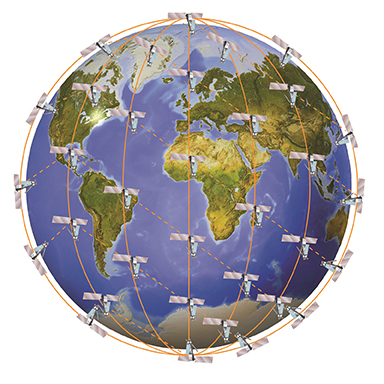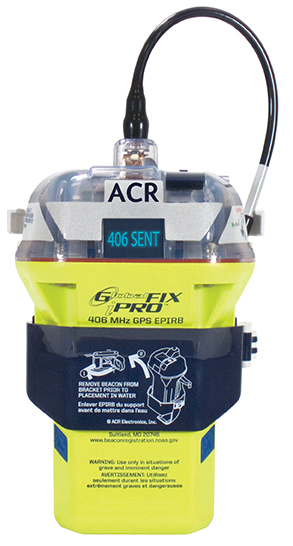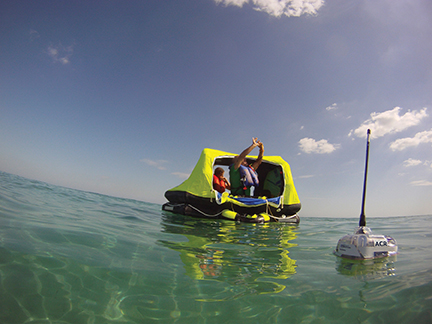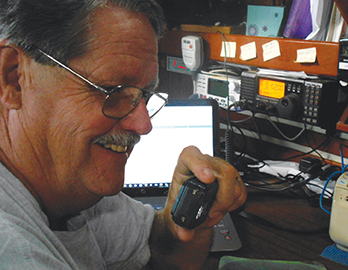When you are off the grid long range communication gets more difficult. Sometimes the best solutions are different than you think they might be. Let’s go through the options. There are three (published February 2016)
The first is the easiest: you may not need long range communications at all beyond the obvious EPIRB. If you will only be out of range of shore services for a few hours, for example from Southeast Florida to the Bahamas, you may not really need long range communications. It is getting more and more difficult to truly be off the grid, at least in terms of communications, anywhere in sight of land.
If you are making offshore passages that last longer than good weather forecasts (Newport to Bermuda, Norfolk to Abacos, San Diego to Baja for example) some long-range communications are well advised. That leads us to the other two options: satellite phones and HF/SSB.

SATELLITE PHONES AND HF/SSB
Satellite phones are commercial services. You are dependent on the physics of radio propagation from your phone to one or more satellites and on the operation of some pretty complex systems. The major providers in the Western Hemisphere are Iridium, Globalstar, and Inmarsat. Globalstar (highly inclined low earth orbit (LEO) satellites) and Inmarsat (geosynchronous (GEO) satellites) have poor coverage in high latitudes. As a “bent-pipe” system Globalstar depends on simultaneous line-of-sight to both the user AND to a ground station leaving odd holes in total coverage; that is also why you can have four or five bars on a Globalstar phone and still no connection to the network. Iridium (low inclination LEO satellites) is the only system with truly global coverage.
A fixed equipment installation will substantially outperform any handheld satellite device. Especially for LEO systems (Iridium and Globalstar) you must have good to very good horizon-to-horizon coverage to avoid call drops and data disconnects. In addition, no matter how careful you may be, the risk of dripped on or drenched equipment leading to catastrophic failure is high when you have a handset propped on the dodger and a laptop teetering on your knees. If satellite is your choice for long range communications you WILL want a fixed installation below and a fixed marine grade external antenna. Satellite system performance will always be degraded in rain.

Satellite phones bring with them the complexity of being in virtual countries (country code 8816 for Iridium, for example). Aside from long dialing sequences that means incoming calls are international with extra cost to the people calling you. Costs to friends and family ashore can add up quickly. Alternatively you can train your callers to use two-step dialing (dialing a gateway number in-country followed by your satellite phone number) or yourself pay an additional fee for ‘+1’ access so callers can reach you directly at a U.S. phone number. There are similar services for satellite phone users in other countries.
High frequency (HF) radio using single sideband (SSB) is the classic long range communication mechanism for cruisers at sea. HF/SSB provides voice and data (using SCS Pactor modems or the amateur radio Winlink WINMOR or ARDOP protocols) that girdle the world. Installation does require some research on your part either to DIY or find an installer who does more than just open boxes and connect things together.
When choosing equipment you should be aware that marine radios meet specifications that less expensive ham radio equipment does not. Signal purity and the ability to operate to specification with low input power voltage are the most significant. The general ability to withstand corrosion at sea (circuit boards are conformally coated) is another benefit. Wouldn’t you want your system to work in an emergency even while your battery bank is down to 10.5 VDC?
HF/SSB radio operation does require some basic understanding of signal propagation and frequency selection. Compared to the time we spend learning the details of diesel mechanics, refrigeration systems, and watermakers, learning about propagation is trivial. My own webinar on the subject lasts only two hours. There are lots of other resources, many free, available on the Internet and of course in American Radio Relay League (ARRL) publications available at most libraries. Propagation models for your computer or smartphone can make frequency selection easier but remember that ham radio operators, military services, commercial shipping, and many others spoke across the globe long before computers became embedded in our lives.
RELATIVE MERITS FROM A DAY-TO-DAY POINT OF VIEW
Satellite phones offer direct dial capability that is very attractive. Satellite phones are not nearly as simple to use as cell phones despite the superficial similarity. If you have time-sensitive requirements for direct dial such as elderly parents with aggressive health care needs or business interests that can’t wait for a planned passage of even a few days then satellite phones are likely your best solution for long-range communications. If voice contact with people ashore is substantially more important than e-mail a satellite phone is likely your best solution.
A complete satellite phone installation will cost between $2,500 and $5,000. Installation is definitely practical to do yourself given great care with cable connectors when fishing cables; professional installation will cost $600 to $1,000. Annual costs depend on use, of course, but generally average around $1,000 annually for most cruisers including a compression service.
HF/SSB unlike satellite phones are part of the global GMDSS safety net. While ship-to-shore telephone networks continue to exist they are more clunky than you will experience with satellite phones. Formal and informal HF/SSB nets provide social networking over broad areas that help keep you in touch with fellow cruisers. In addition to helping plan your cruising routes to meet for a beach barbeque somewhere, support networks develop that provide advice for problems. There are outstanding weather resources best available over HF/SSB, not the least of which is weatherfax making synoptic charts available at no additional cost. HF/SSB nets are among the most useful sources of information when you are on passage or otherwise truly off the grid.
HF/SSB costs about $2,700 for equipment; an SCS Pactor modem for e-mail is an additional $1,700. Installation is a bit more complex than a satellite phone but still within the realm of the do-it-yourselfer, especially with a bit of guidance. If you choose to have your HF/SSB system installed, expect costs around $1,200 to $1,500. Annual costs are limited to $250 per year for Sailmail (e-mail over HF/SSB using Pactor) unless you have a General or Extra class amateur radio license, in which case you can use the free Winlink service if you avoid subjects in which you have a pecuniary interest.
HAM RADIO LICENSE
It is worth spending a moment to consider an amateur (ham) radio license. Aside from some minor regulatory issues there is nothing you need to know in order to pass the Technician and General class license exams you should not know to be a self sufficient cruiser. Accordingly you should know the material (not memorize questions and answers) anyway. That leads to the question of why bother? The ham bands provide access to truly incredible services like the Maritime Mobile Service Net, the Sonrisa Net, the Waterway Radio Net, and the SSCA KPK net. Led by cruisers moved ashore and others with an interest in maritime users, net controls have huge antennas and radio installations more powerful than are practical on our boats. Their resources and reach provide services to those of us at sea and in far flung anchorages that are difficult to match. For those already out cruising, the Seven Seas Cruising Association (SSCA) provides U.S. ham exams in major cruising centers throughout the U.S. and across the Pacific. Cruising Europe? Drop them a line and they’ll work to get you licensed.
Back on the Marine bands, Rene Stiegler and his team at ShipCom carry the mantle of AT&T High Seas Radio providing weather information, ship-to-shore phone patches, and e-mail. Prices are very competitive. See http://shipcom.com/.
For data such as e-mail (including gribs) Iridium and WINMOR are about the same speed. Globalstar is a little faster. Pactor 3 is a good bit faster and Pactor 4 is faster yet. Short version: a well operated HF/SSB installation with Pactor is the fastest way to move e-mail on and off your boat.
If you choose a satellite phone for your long range communications needs, I strongly recommend acquiring and installing a portable SSB-capable shortwave radio. A radio, an interconnecting cable, some free software on your laptop and for less than $250 you can receive synoptic charts over weatherfax—much better than grib files—for the price of a few amp per hours.
If you choose HF/SSB for long range communications it is hard to beat the Icom IC-M802. For satellite phones the Iridium GO!, 9555, and Pilot all have great merit depending on your specific needs.
Dave Skolnick is a degreed naval architect and marine engineer. An avowed radio geek, he has personal experience with HF and satellite systems for long range communications and VHF/UHF for line of sight. He has worked on military, commercial, and recreational ships and boats throughout his career. Dave is an active delivery skipper and provides electronics and communications installation, repair, and operational support in Annapolis MD. Dave is a past president of the Seven Seas Cruising Association.
THE LIFE RAFT ARGUMENT

A satellite phone can indeed be carried onto a life raft while an HF/SSB radio cannot. That isn’t important. The most critical piece of electronics to carry onto a life raft is an EPIRB. Certified as life safety equipment and part of GMDSS an EPIRB is the most likely device to bring help when life goes very very bad. Second most important is a fully-charged handheld VHF to communicate with search and rescue resources on scene. Third is a means to keep your VHF charged, either spare batteries or a solar panel or both. A very distant fourth is a satellite phone. The principal value of a sat phone in a life raft is as a morale device for those aboard that someone is actually coming. If you depend upon a sat phone for your primary reporting mechanism you delay your rescue compared to an EPIRB and complicate on-scene coordination compared to a VHF.















